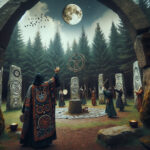The sun has been worshipped by many cultures throughout the ages, from the Egyptians to the ancient Greeks. The sun god, or solar deity, is an important figure in mythology and religion, and has been venerated by many ancient civilizations. This article will explore the worship of the pagan sun god, from his origins in the ancient world to his role in modern paganism. It will examine the various aspects of the sun god, his attributes and associations, and the rituals and festivals that revolve around him. Finally, it will look at how this powerful deity continues to influence modern paganism.

The pagan sun god is a figure in many ancient religions and cultures. He is commonly seen as a symbol of power, strength, and life, and is often associated with the sun and its heat. He is also seen as a protector of the land and its people, and is sometimes referred to as the bringer of light, knowledge, and fertility.
Who is the Pagan Sun God?
The pagan sun god is a deity found in many ancient religions and cultures. He is usually depicted as a male figure with a sun-like face, often with a radiant crown on his head. He may be seen as an embodiment of the power of the sun and its heat, or as a god of life and fertility. In some cultures, he is seen as a protector of the land, its people, and its crops.
The sun god is also seen as a symbol of knowledge and wisdom. He is sometimes associated with the sun’s light and heat, which are seen as sources of light, knowledge, and fertility. He is sometimes seen as a bringer of life and prosperity, and is often associated with the sun’s cycle of life and death.
The Pagan Sun God in Ancient Religions
The sun god was worshipped in many ancient religions and cultures, including the Greeks, Romans, Egyptians, and Aztecs. He was usually associated with the sun’s power and heat, and was sometimes seen as a protector of the land and its people. He was also seen as a source of knowledge and fertility.
In Greece, the sun god was known as Apollo. He was associated with the sun’s power, strength, and life, and was often depicted as a young man with a radiant crown on his head. He was seen as a bringer of light and knowledge, and was often associated with the sun’s cycle of life and death.
In Rome, the sun god was known as Sol Invictus, or “invincible sun”. He was seen as a powerful god and a bringer of light and knowledge. He was also seen as a protector of the land and its people, and was associated with the sun’s cycle of life and death.
In Egypt, the sun god was known as Ra. He was often depicted as a falcon-headed man with a sun disk on his head. He was associated with the sun’s power and heat and was seen as a bringer of knowledge and fertility. He was also seen as a source of life and prosperity, and was often associated with the sun’s cycle of life and death.
The Aztecs also had a sun god, known as Tonatiuh. He was usually depicted as a fierce warrior with a sun-like face. He was seen as a bringer of knowledge and fertility, and was associated with the sun’s power and heat. He was also seen as a protector of the land and its people, and was often associated with the sun’s cycle of life and death.
The Pagan Sun God in Modern Culture
The pagan sun god is still seen in modern culture, albeit in a more abstract form. He is often depicted as a symbol of power, strength, and life, and is still seen as a bringer of light, knowledge, and fertility. He is also seen as a protector of the land and its people, and is still associated with the sun’s cycle of life and death.
The pagan sun god is often seen in art, literature, and music. He is often depicted as a source of power and life, and is seen as a bringer of light, knowledge, and fertility. He is also seen as a protector of the land and its people, and is often associated with the sun’s cycle of life and death.
The pagan sun god is also a popular figure in modern pagan religions. He is seen as a source of power and life, and is often associated with the sun’s power and heat. He is also seen as a bringer of light and knowledge, and is often associated with the sun’s cycle of life and death.
Conclusion
The pagan sun god is a figure found in many ancient religions and cultures. He is usually seen as a symbol of power, strength, and life, and is often associated with the sun and its heat. He is also seen as a protector of the land and its people, and is sometimes referred to as the bringer of light, knowledge, and fertility. He is still seen in modern culture, albeit in a more abstract form. He is often depicted as a source of power and life, and is still seen as a bringer of light, knowledge, and fertility. He is also seen as a protector of the land and its people, and is still associated with the sun’s cycle of life and death.
The Pagan Sun God has been a powerful figure in many cultures throughout history. He is often associated with the sun, light, warmth, and life. He is a symbol of hope, strength, and fertility. He is a reminder of our connection to the natural world and the power of the sun. He is a reminder that we are all connected and that we can find strength and guidance in the natural world. His presence can be felt in many aspects of life, from the warmth of the sun to the fertility of the land. Ultimately, he is a reminder of our connection to the divine and the power of the sun. The Pagan Sun God is a powerful symbol of hope, strength, and fertility, and a reminder of our connection to the divine.





